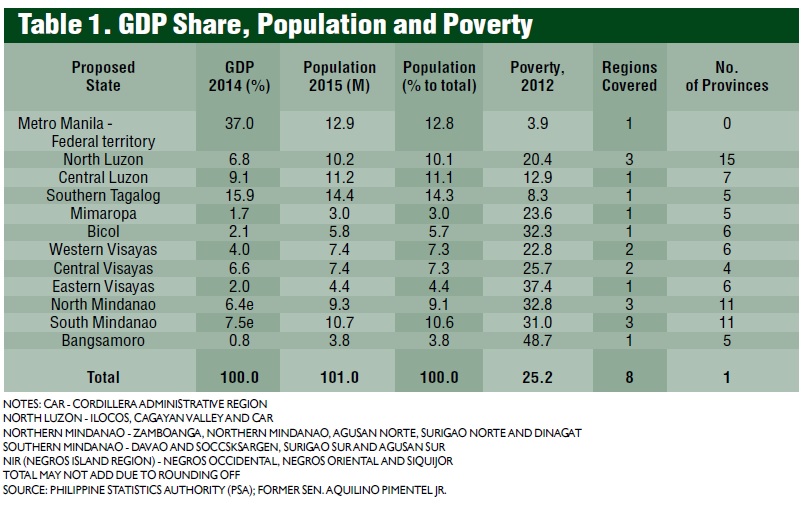Creating federal states
The Duterte administration wants a strategic shift to a federal government from a unitary form. Examples of federal states are Australia, Germany, United States and closer to home, Malaysia. The major unitary states include China, Japan, United Kingdom and Indonesia.
Federalism is a form of government that allows delegation of power to the states. By contrast, under a unitary system, powers are centralized and the central government has the authority to make all the decisions.
This article will discuss some economic aspects of the proposed federalism in the Philippines. Former Senator Aquilino Pimentel Jr. has proposed 11 states, and one federal territory, Metro Manila.
A federal territory is akin to Kuala Lumpur and Putra Jaya in Malaysia and Washington, D.C. in the United States. They are directly governed by the federal government.
As a comparator, Malaysia with a population of about 30 million has 13 states. The average population per state is about 2.2 million people, the largest is 4.2 million and the smallest 0.2 million.
In the case of the Philippines, an analysis of current conditions shows wide disparities in gross domestic product (GDP) share, population and poverty.
The Bangsamoro geography does not make economic sense. It has five provinces that are separated by about 380 kilometers of waters from Cotabato City to Jolo, Sulu. The Eastern part (Lanao del Sur and Maguindanao) has a population of 2.2 million; and the Western part (Basilan, Sulu and Tawi Tawi) has 1.6 million. It would be better, sans emotional issues, if they will have two states: Eastern Bangsamoro, and Western Bangsamoro. Cotabato and Jolo will be the state capitals. Both have good resources to tap for agricultural and sectoral development.
While federalism would be beneficial to many states, the quality of governance and human resources remains a challenge. Concerns have been raised that under federalism, poorer states will not fare well because of poor resources. That is not entirely true.
Mindanao has rich resources but generally poor. The lower poverty rates of certain regions (Central Luzon and Southern Tagalog) can be attributed to several factors: Nearness to Metro Manila and the presence of many manufacturing and service industries.
Today, adjacent provinces have wide poverty incidence gaps. For example, Nueva Ecija 25.2 percent vs Pampanga 7.6 percent; Negros Occidental 32.3 percent vs Negros Oriental 50.1 percent; Sultan Kudarat 48.5 percent vs South Cotabato 32 percent.
To address the high poverty gap, the future federal government can allocate a development fund to bridge the resource gap of poor provinces. Projects, such as land consolidation and development, can be administered jointly using qualified management teams from the private sector and the academe.
(The article reflects the personal opinion of the author and does not reflect the official stand of the Management Association of the Philippines or MAP. The author is the vice chair of the MAP AgriBusiness and Countryside Development Committee, and the Executive Director of the Center for Food and AgriBusiness of the University of Asia & the Pacific. Feedback at <map@map.org.ph> and <rdyster@gmail.com>. For previous articles, please visit <map.org.ph>)


